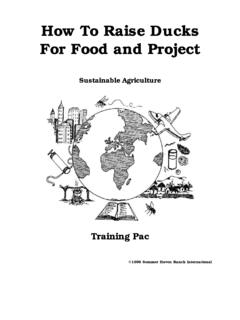Transcription of A Simple Guide to Duck Raising - Trinidad & Tobago
1 A Simple Guide to DuckRaisingThe Ministry of Food Production,Land and Marine AffairsPartners in Sustainable Community Development Table of Contents 1 Preface 2 2 Introduction to duck rearing 3 3 Types of Ducks 4 4
2 Advantages of duck Farming 5 5 How many ducks should you raise? 6 6 Choosing a place to raise ducks 7 7 How to choose good ducks 8 8 How to handle your ducks 8 9 How to keep ducks safe and well 10
3 10 After you get your ducks 11 11 Nests 14 12 Raising Baby Ducks 15 13 Water 17 14 Feeding 18 15 duck Health 19 1 Preface This manual is designed as a resource
4 Guide to the participants of the Turtle Village Trust Agricultural Training Programmes. It is intended to give an intermediate approach to Guide the reader/farmer in the basics of duck rearing with the intention of establishing a sustainable enterpris e. Turtle Village Trust would like to acknowledge our partners in sustainable community development BHP Billiton, JB Fernandes Memorial Trust and Atlantic LNG without whom this valuable resource would not be possible. Turtle Village Trust would also like to thank the Ministry of Food Production for their support in this project and all others who contributed in making this endeavor possible.
5 Dr. Allan BachanPartners in Sustainable Community Development 2 The Ministry of Food Production,Land and Marine Affairs2. Introduction to duck Raising duck Raising in Trinidad and Tobago , like Raising chickens for meat, can be a full-time specialized business requiring efficiency. The growing commercial market for duck meat is linked with the increasing population. duck meat generally commands a good price, well above the prices received for chicken. The meat is marketed as fresh, frozen and chilled products, either whole or in parts.
6 There are problems associated with keeping ducks for egg production on a large scale because of low egg numbers, high feed consumption and the need to house ducks in small numbers. The main egg-laying breeds of ducks can lay more and larger eggs than can hens, but ducks eat about 75% more feed. For these reasons, most farmers concentrate on meat production. Ducks rearing is being promoted to small community farmers as a means of sustainable livelihood development. There are also a few smaller family farms that have ducks grown for them on contract farms, as well as operators who are involved in all aspects of production, plucking and including direct sales.
7 Basic duck Care Ducks are raised under a wide variety of conditions, ranging from a backyard coop for a few ducks to housing for large flocks on a commercial duck farm. Regardless of the category of duck keeping, there are certain basic requirements that must be met if ducks are to remain healthy. This booklet is intended to educate duck farmer with regard to meeting these basic requirements. Ducks adapt well to a wide range of systems of care provided they receive essential basic care. Except for the early brooding stage, when ducklings require a higher temperature and special attention by the farmer, the basic requirements of ducks are outlined in this Guide duck Care Standards The environment that ducks are kept in must be designed to promote duck well-being and protect ducks from discomfort and distress.
8 Ducks are known to be strong birds. They are not affected easily by some bird diseases not like turkeys and chickens. However, you still need to practice proper care. Choosing what breed you want to keep is important. There are duck breeds that are more suited for particular purposes like providing meat or giving eggs. Hope this Simple duck farming Guide gave a head start in your new venture. 3 3. Types of Ducks The Muscovy duck belongs to the genus Cairina and originated in South America. It is a good multipurpose breed and has good flavour meat.
9 It is a medium egg producer. The young are hardy and easy to rear. It is a good grazer and thus ideal for back-yard operations. The male Muscovy can become very large ( to kg) while the female is smaller ( to kg). Market Age 12weeks. Muscovy differs from other breeds in the following ways: It goes broody and will sit on and hatch eggs of other breeds as well as its own. It flies, and perches on roosts and trees. If already mated with members of its own breed, it will not mate with members of other breeds. Where cross-matings are successful, the crossbred progeny are infertile and are known as mules.
10 The drake, unlike in other breeds, has no curl feathers in his tail. Both male and female Muscovies hiss rather than quack . Muscovies are poor egg producers, and lay their eggs in clutches; that is, they may lay 20 or so eggs and go broody or pause before producing again. Its eggs take 35 days to hatch, whereas eggs of other breeds take only 28 days. Its meat has a lower fat content than that of other ducks. The Pekin duck is ideal for commercial production due to its good egg producing capabilities and hatchability.






